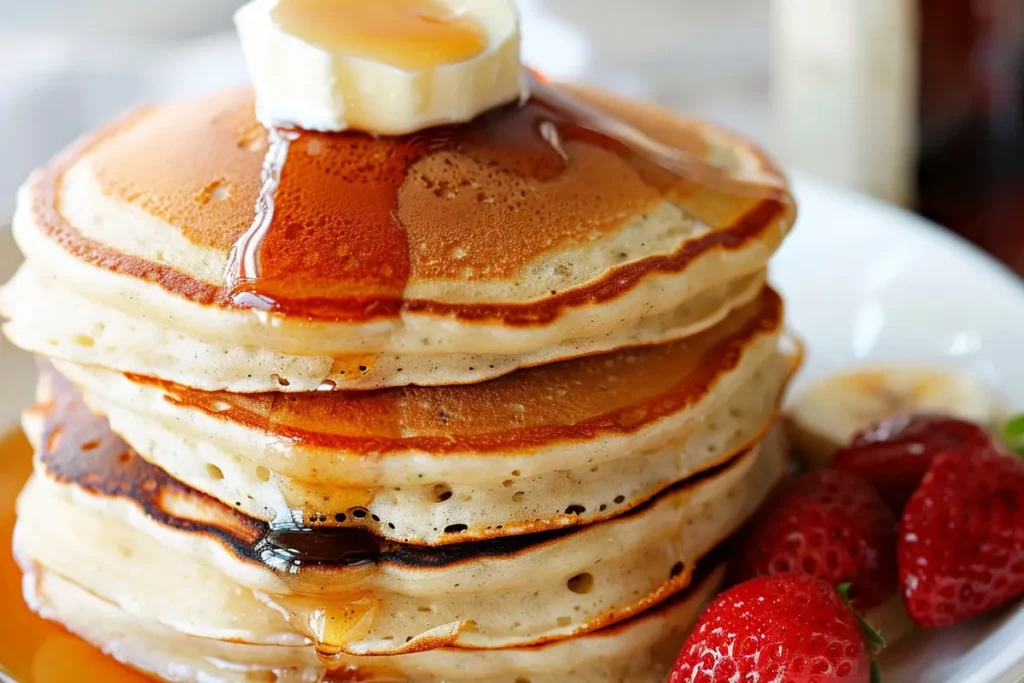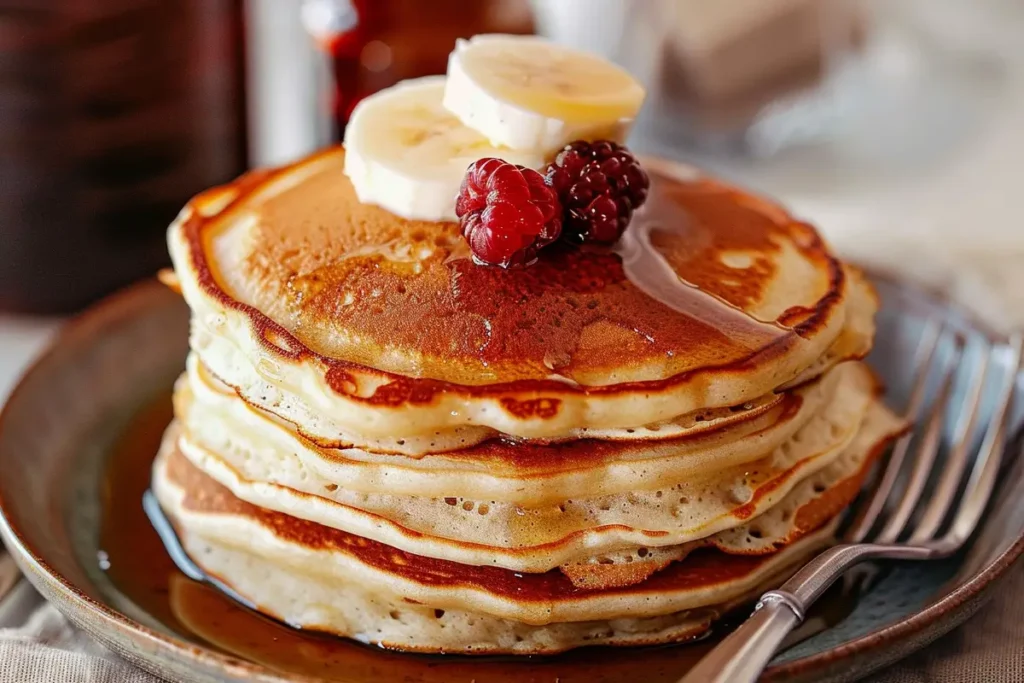Table of Contents: Can I Use Mayo Instead of Eggs in Pancakes?
Introduction: Can I Use Mayo Instead of Eggs in Pancakes?
Who knew a simple swap could save your pancake breakfast? If you’ve ever found yourself mid-recipe only to realize you’re out of eggs, don’t panic—mayonnaise might just be your secret weapon! Creamy, rich, and packed with the right fats, mayo can step in as an unexpected (but genius) egg substitute in pancakes.
Believe it or not, this trick isn’t as wild as it sounds. Mayo is made from eggs and oil—two key ingredients in fluffy pancakes—so it actually works surprisingly well. Think of it like our popular 3-Ingredient Banana Pancakes, where simplicity saves the day. Whether you’re out of eggs or just feeling adventurous, this hack delivers tender, golden pancakes every time.
Ready to flip the script on your breakfast routine? Let’s dive in!
What Is Mayo in Pancakes?
Wait… mayo in pancakes? Before you scrunch up your nose, hear us out! This isn’t some bizarre kitchen experiment—it’s a legit baking hack that’s been saving breakfasts for decades.
Think about it: mayo is just eggs and oil emulsified together—two things pancakes already love. So why not use it? (Unless you’re the type who also questions putting avocado in brownies—trust us, that works too.)
As the old saying goes, “The way to a man’s heart is through his stomach,” and honestly, the way to perfect pancakes might just be through your condiment drawer. Ready to give it a try?
Why You’ll Love This Hack

- No Eggs? No Problem! – Ran out of eggs last minute? Mayo saves the day with its egg-and-oil combo, keeping pancakes moist and fluffy.
- Budget-Friendly Breakfast – Skip the extra grocery trip—just use what’s already in your fridge.
- Surprisingly Delicious – The mayo adds a subtle richness without any weird taste (promise!). Top with maple syrup, fresh berries, or whipped cream for a next-level stack.
If you love easy swaps like Fluffy Yogurt Pancakes, you’ll appreciate this clever trick. Time to upgrade your pancake game!
How to Make Mayo Pancakes
Quick Overview
✅ Prep Time: 5 mins
✅ Cook Time: 10 mins
✅ Total Time: 15 mins
✅ Servings: 6-8 pancakes
These pancakes come out golden, tender, and just as fluffy as the classic version—minus the eggs!
Key Ingredients
- 1 cup all-purpose flour
- 1 tbsp sugar
- 1 tsp baking powder
- ½ tsp baking soda
- ¼ tsp salt
- ¾ cup milk (or buttermilk for extra fluffiness)
- 3 tbsp mayonnaise (not Miracle Whip)
- 1 tbsp melted butter (or oil)
- 1 tsp vanilla extract (optional)
Step-by-Step Instructions
- Mix Dry Ingredients – Whisk flour, sugar, baking powder, baking soda, and salt in a bowl.
- Combine Wet Ingredients – In another bowl, mix milk, mayo, melted butter, and vanilla.
- Fold Together – Gently stir wet into dry ingredients—don’t overmix! A few lumps are fine.
- Cook Pancakes – Heat a greased skillet over medium. Pour ¼ cup batter per pancake. Flip when bubbles form (about 2-3 mins per side).
- Serve Warm – Top with butter, syrup, or fresh fruit. Enjoy!
What to Serve With Mayo Pancakes
- Classic Combo: Maple syrup + crispy bacon
- Fresh & Fruity: Sliced bananas + whipped cream
- Decadent Twist: Nutella drizzle + toasted hazelnuts
Top 5 Tips for Perfect Mayo Pancakes
- Use Full-Fat Mayo – Light mayo can make pancakes dry.
- Don’t Overmix – Lumpy batter = fluffier pancakes.
- Adjust Thickness – Add a splash more milk if batter is too thick.
- Low & Slow Cooking – Medium heat prevents burning.
- Test a Mini Pancake First – Adjust seasoning or sweetness if needed.
Storing & Reheating Tips
- Fridge: Keep in an airtight container for up to 2 days.
- Freezer: Layer pancakes between parchment paper; freeze for 1 month.
- Reheat: Microwave (20 sec) or toast for crispiness.
FAQs: Can I Use Mayo Instead of Eggs in Pancakes?

Q: Does mayo make pancakes taste weird?
A: Not at all! Mayo is made from eggs and oil, so it blends right into the batter. The result is a slightly richer, fluffier pancake with no noticeable mayo flavor.
Q: Can I use light mayo instead of regular?
A: We recommend full-fat mayo for the best texture. Light mayo has more water, which can make pancakes less tender.
Q: How much mayo replaces one egg?
A: For most pancake recipes, 3 tablespoons of mayo = 1 egg. Adjust based on your preferred thickness.
Q: Can I use vegan mayo?
A: Yes! Vegan mayo (made with plant-based oils) works as an egg substitute, though the texture may vary slightly.
Q: Will these pancakes be greasy?
A: Not if you measure correctly. Mayo adds moisture, but proper cooking ensures golden, non-greasy results.
Conclusion: Can I Use Mayo Instead of Eggs in Pancakes?
Who knew your condiment shelf held the secret to perfect pancakes? Mayo isn’t just for sandwiches—it’s a brilliant egg substitute that saves the day when you’re in a breakfast bind. These pancakes come out fluffy, golden, and delicious, proving that sometimes the most unexpected swaps work best.
Whether you’re out of eggs, cutting grocery costs, or just love kitchen experiments, this hack deserves a spot in your recipe rotation. Serve them with classic maple syrup, fresh fruit, or even a dollop of extra mayo (hey, no judgment here!).
Give it a try this weekend—your taste buds (and your wallet) will thank you! And if you’ve got another clever pancake hack, share it in the comments below. Happy flipping! 🥞
Print
Easy Classic Pancakes
- Total Time: 15 mins
- Yield: 8–10 pancakes 1x
- Diet: Vegetarian
Description
Fluffy, golden, and irresistibly buttery—these Easy Classic Pancakes are a breakfast staple that never disappoints! Made with simple pantry ingredients, they’re quick to whip up and perfect for lazy weekends or busy mornings. Top them with maple syrup, fresh berries, or a dollop of whipped cream for the ultimate stack.
Ingredients
- 1 ½ cups all-purpose flour
- 3 ½ tsp baking powder
- 1 tbsp granulated sugar
- ½ tsp salt
- 1 ¼ cups milk (or buttermilk for extra fluffiness)
- 1 large egg
- 3 tbsp unsalted butter, melted (plus extra for cooking)
- 1 tsp vanilla extract (optional)
Instructions
- Mix dry ingredients: In a large bowl, whisk together flour, baking powder, sugar, and salt.
- Combine wet ingredients: In another bowl, beat the egg, then add milk, melted butter, and vanilla.
- Make the batter: Pour wet ingredients into dry ingredients and stir gently—don’t overmix! A few lumps are fine.
- Cook pancakes: Heat a lightly buttered griddle or skillet over medium heat. Pour ¼ cup batter per pancake. Flip when bubbles form (about 2–3 minutes per side).
- Serve warm: Stack ’em high with your favorite toppings!
Notes
- For fluffier pancakes: Let the batter rest 5 minutes before cooking.
- Dairy-free? Use almond milk and coconut oil.
- Storage: Keep leftovers in an airtight container for up to 2 days or freeze for 1 month.
- Prep Time: 5 mins
- Cook Time: 10 mins
- Category: Breakfast
- Method: Stovetop
- Cuisine: American
Nutrition
- Serving Size: 1 pancake
- Calories: 120 kcal
- Sugar: 2g
- Sodium: 220mg
- Fat: 4g
- Saturated Fat: 2.5g
- Unsaturated Fat: 1g
- Trans Fat: 0g
- Carbohydrates: 17g
- Fiber: 0.5g
- Protein: 3g
- Cholesterol: 25mg
Keywords: easy pancakes, fluffy pancakes, classic pancake recipe, homemade pancakes, breakfast ideas

